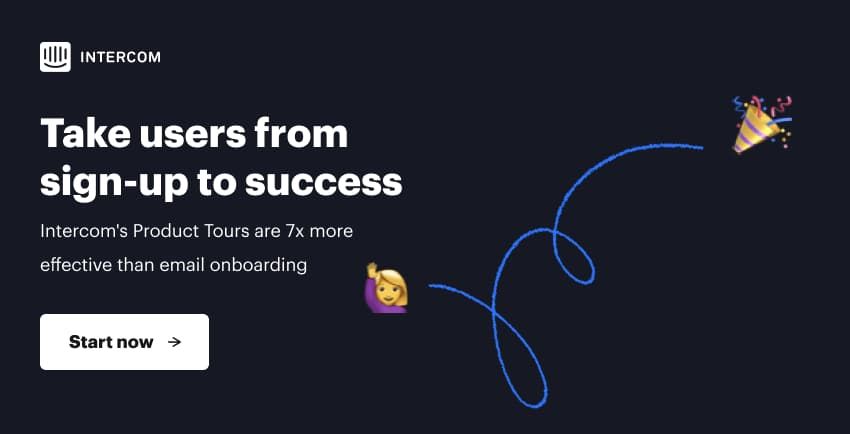
5 messages for every onboarding campaign
Main illustration: Emily Haasch
Most of the writing on onboarding focuses exclusively on what’s happening on the interface.
Advice on modals, tooltips, and gestures is easy to come by. What all of it ignores is what’s happening in the 30 days after a customer signs up to your product. Pixel-perfect interactions are useless if customers aren’t getting value from the features they signed up for.
Successful onboarding is less about getting users through the first three screens, and more about demonstrating value to customers – fast. And the single best way to ensure users are getting continuous value is through messaging. It can help you to show customers:
- why they’re there,
- what they can accomplish,
- and what to do next.
Messaging can hit all three of these better than any fleeting product tour can.
The single best way to ensure users are getting continuous value is through messaging
Here’s a series of messages that will guarantee new signups get the most out of your product.
1. Welcome message

Welcome messages are more likely to be opened, clicked on, and responded to than any other message. You’ll never get a second chance at making a first impression so make this message count.
- Extend a warm welcome. You wouldn’t greet someone on the street by saying ‘To whom it may concern.’ Use first name variables and greet customers by their first name.
- Introduce yourself. The days of Microsoft’s Clippy are thankfully behind us. Nobody likes doing business with an anonymous avatar. Introduce yourself to show new customers there’s a real person behind your product.
- Set a nice tone for your product. It’s not just what you say but how you say it. A friendly, conversational tone will directly impact whether your subsequent onboarding messages get read.
- Call to action. Think about what you want your customers to actually do when they first start using your product – that should inform everything else. Then make this goal the single call to action in your email e.g sign up to a webinar, update their profile page, etc.
2. Follow-up message

Ok, so your new users have set up an account, they’ve been warmly welcomed, and you’ve yet to hear anything back. Everything must be rosy, right? Wrong. Don’t confuse causation with correlation. There might be some rare cases where things are going 100% perfectly, but when it comes to new signups, assume nothing.
Simply communicating with your new signups is a great way to tease out questions they might not bother contacting you for, but that are blocking them from getting real value from your product. By proactively starting a dialogue they’re far more likely to say things like “How can I create a new project” or “How do I invite a teammate ?”.
A few days after they’ve signed up, send new customers a follow-up message to let them know you’re there to help if they need anything.
3. Activation message

Most users who sign up for a product use it just once. This is especially true for products with a free trial. Just because someone has made it through the intro tour doesn’t mean they’ve committed to it. They could have as easily read the TechCrunch article your product was mentioned in and be curious to check it out. Again, assume nothing.
The channel here is important. Make this message an email, or a push notification. An in-app message won’t activate new signups if they’re not signing in to begin with.
- Sell the value. This is onboarding 101 – don’t tell people to do something; motivate them to do it. Remind customers of the job your product solves, and how using a particular feature can help them solve it.
- Make action easy. Always link directly to the page where they can complete the action. Deeplinks cost nothing, but save unfamiliar signups from searching for features they likely have never heard of.
- Use active language. Don’t treat new users as a scorned lover. “Come back, we miss you” might get someone to sign back in, but is unlikely to inspire confidence in your product in the long run.
- Set expectations. The biggest obstacles in your way are effort and time. If it won’t take long for new users to get up and running, let them know. For example, you could say, ‘It only takes a minute to create a project.’
4. Education message

Onboarding isn’t measured in number of tasks completed, it’s measured in how you make people more successful. Just because a new signup has finished the progress bar on the product dashboard doesn’t mean they’re any further in getting the value they signed up for.
Sometime in the first 30 days, you’re going to have to stop telling people to start doing something and start showing them instead.
For example, if your customers have used your project feature for the third time, you could introduce them to your best practices on how to make a project schedule and how to organize their documents and files. The customer’s ultimate goal isn’t to create a project – it’s to work with a group and keep everyone on the same page. A message like this gets them one step closer to that successful moment.
It almost goes without saying, but make sure to trigger these messages based on behavior. In the case above, you could add a rule to your message such as “Created project count is 3”.
5. Nudge message

Whenever new signups aren’t using a feature they could benefit from, onboarding opportunities abound. Look at a new signup’s onboarding trajectory not as whether they’re fully set up in your product, but whether they’re becoming better at solving the jobs they hired your product for.
Let’s say a new signup has created a project, they’ve created a schedule, and have started to organize their documents. But they haven’t actually shared it with anyone yet.
If your product has features that will really help people, let them know. Introduce this related feature in context (while they’re creating a project) and tell them how to make the most of it.
Delivering ongoing value to signups
One of these messages in isolation won’t deliver engaged users overnight. But taken collectively, a series of onboarding messages gives you the best chance of converting new signups on a free trial, or making sure those who are already paying stick around. Done right, it’ll help you keep pace with how new signups are reacting to the first 30 days, and remove any stumbling blocks they encounter along the way.
Sure, creating a series of onboarding messages isn’t as easy as having a one-size-fits-all product tour (though using tools like Intercom to send messages certainly makes it a lot easier). But providing long-term value for you and your users shouldn’t be easy.








